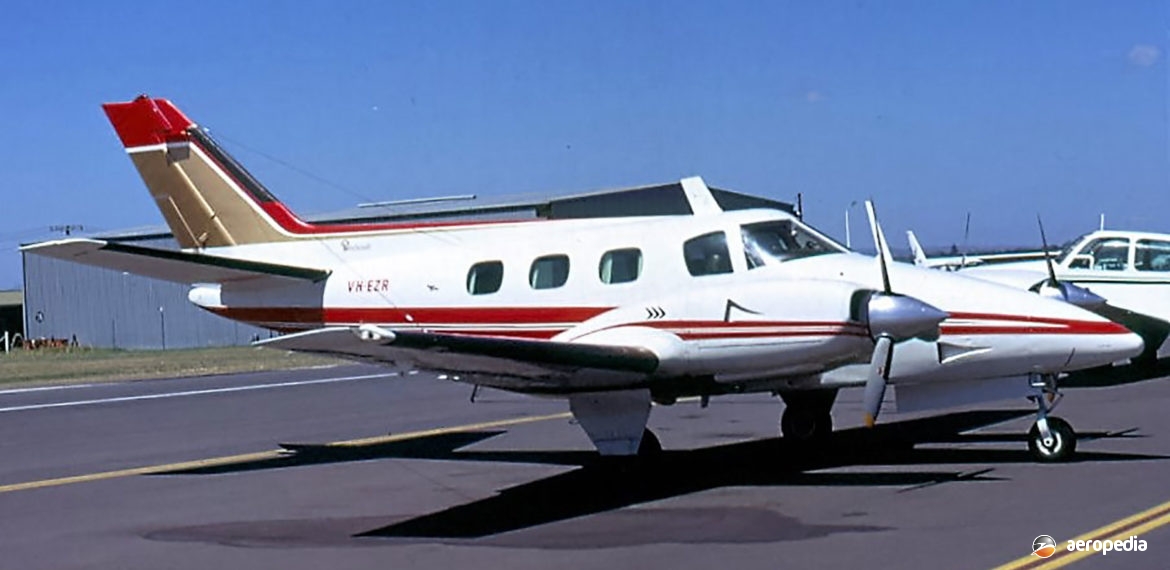Photograph:
Beech A60 Duke VH-EZR (c/n P199) at Moorabbin, VIC in December 1973 (David C Eyre)
Country of origin:
United States of America
Description:
Business and executive aircraft
Power Plant:
(B60)
Two 283 kw (380 hp) Lycoming TIO-540-E1C4 turbo-charged six-cylinder horizontally-opposed air-cooled engines
Specifications:
- Wingspan: 11.97 m (39 ft 3¼ in)
- Length: 10.31 m (33 ft 10 in)
- Height: 3.76 m (12 ft 4 in)
- Wing area: 19.78 m² (212.9 sq ft)
- Max speed at 7,010 m (23,000 ft): 460 km/h (286 mph)
- Cruising speed at 7,620 m (25,000 ft) at 75% power: 432 km/h (268 mph)
- Economical cruising speed at 6,100 m (20,000 ft): 330 km/h (205 mph)
- Initial rate of climb: 488 m/min (1,601 ft/min)
- Service ceiling: 9,145 m (30,000 ft)
- Range at 330 km/h (205 mph) at 6,100 m (20,000 ft): 2,274 km (1,413 miles)
- Empty weight: 1,939 kg (4,275 lb)
- Loaded weight: 3,073 kg (6,775 lb)
History:
Designed to fill the gap between the Beech Baron series and the Beech Queen Air in the Beechcraft range, the Model 60 Duke, when it first appeared, was the cheapest fully-pressurised four/six-seat high-performance aircraft with turbo-charged engines. Following its inception, it proved quite popular throughout the world with its superb appearance and performance. The Duke was the smallest aircraft in the business and executive field with a side-entry door and central aisle between the seats. It was described as having a ‘beefed up’ Bonanza/Baron wing mated to a new fuselage and undercarriage, powerful 283 kw (380 hp) Lycoming engines, a taller, sharply raked fin and swept tailplane.
The prototype of the Duke series flew for the first time on 29 December 1966, and production deliveries began in July 1968. Some 31 aircraft were delivered during the course of that year, and a production rate of eight aircraft per month was set for the following year. Four seats were fitted as standard, but two more seats could be added. A large baggage compartment was available in the nose and the entire aft section of the cabin could be converted to cargo space if required by folding down the seats. Cabin pressurisation was set so that sea level pressure was maintained up to 3,048 m (10,000 ft), and a cabin altitude of 2,438 m (8,000 ft) was maintained at the aircraft’s cruising altitude of 6,653 m (21,500 ft). At this height, with maximum optional fuel and 45 minutes reserve, the aircraft had a range of 2,274 km (1,413 miles) travelling at 330 km/h (205 mph).
The Duke was described as “exclusive and highly desirable…is a fast, nice to fly, stratospheric mini-airliner which clearly means business. It has long been known as the Mercedes Benz of twins”.
As the aircraft was developed and produced, like other Beechcraft models, new model numbers appeared. New models of the Duke received an initial letter before the Model 60 number, thus becoming B60, etc. In 1971 the A60 appeared with lighter more efficient turbo-chargers and a new instrument layout, gross weight being increased to 3,073 kg (6,775 lb), and fuel capacity being raised to 765 litres (168 Imp gals). The B60 was introduced in 1974 and had slightly more interior room, an optional increase in fuel capacity to 878 litres (193 Imp gals) and a new AiResearch pressurisation system.
First of the type seen in this region was VH-ILI (c/n P45 – ex N7648N), a Model 60, which came from the Beechcraft plant at Salina in Kansas, USA. It was flown across the Pacific for Beechcraft Australia and later saw service with Hawker De Havilland, Wigmores Tractors and Civil Flying Services. It later became VH-NYI and was withdrawn from service in April 1995.
Other operators of the type in Australia have included D and N Dalton Pty Ltd with VH-TKE (c/n P6 – ex N2469K); Royal Flying Doctor Service of Australia VH-IFD (c/n P40 – ex N1745U) ‘Airdoctor One’, and VH-UFD (c/n P237 – ex N1869W) ‘Airdoctor Two’; Bonanza Air Charter Pty Ltd VH-EZR (c/n P199); Percheron Transport VH-EZT (c/n P244 – ex N25664); Piccadilly Pastoral Co VH-DUK (c/n P246 – ex N25663); David B Knox Pty Ltd VH-TEI (c/n P266 – ex N 4419W); West Riding Pty Ltd VH-WRA (c/n P280 – ex N4364W); and R E Johnston Constructions Pty Ltd VH-RJU (c/n P281 – ex N7343R), etc.
In New Zealand one A60 was registered to F P Radisich of Thames ZK-FRA (c/n P199).
In 1975 VH-TKE was flown around the world by Denys Dalton and the late Terry Gwynn-Jones in a time of 122 hours 40 minutes, leaving Brisbane, QLD at 0500 on 19 July and returning at 0804 EST on 24 July, flying via Tarawa Island, Hawaii, San Jose in California, Toronto in Canada, Gander in Newfoundland, London in the United Kingdom, Beirut in Iraq, Dubai in the United Arab Emirates, Madras in India, Singapore, and Macassar in Indonesia, returning to Brisbane.
A total of 584 Dukes had been built when production ceased in 1982. This figure comprised 113 Model 60, 121 Model A60, and 350 Model B60. At least fifteen examples have been registered in Australia over the years.
The engines of the Duke developed a reputation for being unreliable. To deal with this problem Rocket Engineering of Spokane, Washington, commenced to re-engine a number of Model B60s with 410 kw (550 shp) Pratt & Whitney PT6A-21 or PT6A-35 turboprops, giving the aircraft a max speed of 555 km/h (345 mph). Various other modifications were made, including vortex generators and extra fuel tanks. The first conversion was N156JJ (c/n P589) and the modified aircraft became known as the Royal Turbine Duke. Some 21 aircraft were converted but none are known to have come to this part of the world.

